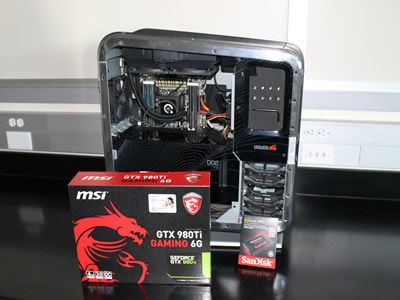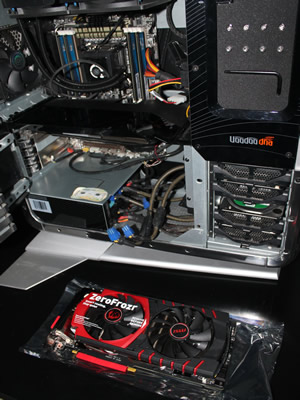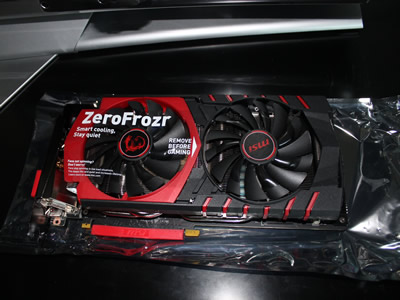Blackbird Graphics Upgrade
I have the most awesome gaming PC in the whole world. (I also have the best wife and the cutest dog. I'm just a lucky guy.) I got an HP Blackbird PC for Christmas in 2007 while I lived in Singapore. Even though it will be nine years old this year, I still have it. I did a major upgrade of the system once before, in the spring of 2012. Most of the guts were replaced: motherboard, processor, video card, hard drives, even the power supply. Pretty much all that is left of the original is the case, but like a classic car that's been rebuilt, it is still a thing of beauty.
This spring it was time for an upgrade again. My videocard was a Radeon 7950 from Gigabyte which had plenty of power to handle my 30 inch WQXGA display from HP. But last Christmas when I added a 28 inch 4K UHD display, I was really pushing it. Ever since then I have wanted to get a new videocard. It was pretty unusual for me to have an AMD card, since I'm usually an nVidia guy, so this time I was waiting for nVidia to release their new Pascal architecture. It was supposed to be a big improvement over anything currently in the market. But as time went on it didn't seem to be getting closer.
Meanwhile they came out with the GeForce GTX 980 ti based on the current Maxwell architecture. It just seemed to be too good a price/performance deal to pass up. Besides, I wanted to do the upgrade before Ivan and I left the U of I at the end of the spring semester. I really wanted to get help with the upgrade from Pappy Ivan, the PC Master. Just to clarify, "getting help" from Ivan means that he does all the hard work while I look over his shoulder, try to figure out what he is doing, and keep asking "are you sure it's ok to do that?"
We hit the first problem as soon as we took the new video card out of the box. The GTX 980 ti needed two power connectors. I have a power supply with a modular cable system and I only had one cable of the right type. It took me a whole day to track down the power supply manufacturer (from Taiwan) and then the company that imported them (in LA) so that I could call and talk to someone about my problem. Barely. He sounded Chinese and his English was not very good, but eventually I was able to order a replacement cable. A couple of days later it arrived and we were ready to proceed again.
Besides the video card, the only other change this time (not counting a recent upgrade to Windows 10) would be a larger SSD for the main system disc. Should be easy, or so I thought. When we plugged in the new video card and SSD, the monitor was blank and the system wouldn't boot. Ok, that's not good. We backed out the video card to try to isolate the problem. The new SSD wasn't being recognized by the system. It turned out that my old SSD didn't have cache while the new one did, which was confusing the BIOS for some reason. After changing the BIOS settings, Ivan was able to get the system to boot up just fine. Progress. But when we reinstalled the new video card we still got a blank screen.
Actually, that wasn't too surprising. The GTX 980 ti uses PCI Express v3. That wasn't out yet when I had upgraded my motherboard in 2012. But I had been clever and future-proofed my rig last time, buying an Asus Sabertooth z77, a motherboard that was "PCI Express 3 ready". No problem. Just load new firmware for the mobo and it would be good to go, right?
Wrong. The new mobo firmware wouldn't load. Researching on the web revealed that about a year ago, Asus had changed the file format for firmware downloads for the z77. Now older boards could no longer load new firmware releases. We were stuck.
Well Ivan always says that he likes tough technical challenges, so he wasn't going to let this stop him. First, he erased all the firmware on the motherboard. Then he found a special program that let him install the bootloader on the motherboard, but one that could interpret the new file format. Then he installed the latest version of firmware. Simple, right? Now the system would recognize my new video card and boot up in Windows.
There was still a problem. The display was low resolution. It was only running PCIe 2, not PCI 3. So there wasn't enough bandwidth for high resolution. Although the motherboard and video card were happy with PCI 3, for some reason Windows didn't think they could handle it and was restricting them to the older version of the interface. Eventually Ivan was able to write a script to modify some registry keys where Windows kept the IO mask it used for this. Finally, the new stuff was running, at full resolution and bandwidth. It had taken Ivan a whole week to solve all of the problems. But now my system was kicking ass. I was really happy with the performance of my new graphics card. Ivan was happy because he got my previous Radeon card which could drive the large display on his home system.
Unfortunately, that wasn't the end of the story.
Less than a month after my system upgrade, I got an email from nVidia announcing the GeForce 1070, the first of a new product line based on the Pascal architecture. Why now? I was still happy with what I had, but it wouldn't have hurt them to wait a little longer before introducing the 1070.
But wait. There's more. When I got my system home, I found that I couldn't get sound. After a lot of debugging I found that sound was playing, but that no matter what selections I made it was routing over HDMI instead of through the audio jacks. That didn't work for either my speakers or my gaming headset. They have 3.5mm jacks. I tried everything I could think of. Uninstalling the nVidia drivers. Loading and reloading the audio drivers for the motherboard. Playing with settings in the Realtek audio manager. Nothing worked. Ivan came over to help one evening and even he couldn't figure it out. Probably all the things that we did to get the PCI 3 working somehow messed up the chipset audio drivers. Or maybe it was something totally different. Who knows?
There was a workaround, plugging into the audio jack on my 4K monitor. That was fine for my headset but my speakers had a terrible hum. I thought it was a ground loop but Ivan finally traced it to a bad connection on the back of the monitor. With appropriate jiggling, I could make the hum go away. So my speakers worked ok. Now I just needed to get my headset working. But then there was a happy accident. At least, we'll say it was an accident. During the debugging process my headset got broken. That actually wasn't a bad thing. It gave me an excuse to switch to a USB headset (and upgrade in the process). I got a HyperX Cloud II. Usually gaming headsets don't have sound as good as dedicated headphones, but when I tried my new Cloud II it was absoulutely amazing! So after all that effort, both my video and my sound is much better than it was before.
And I gamed happily ever after.



